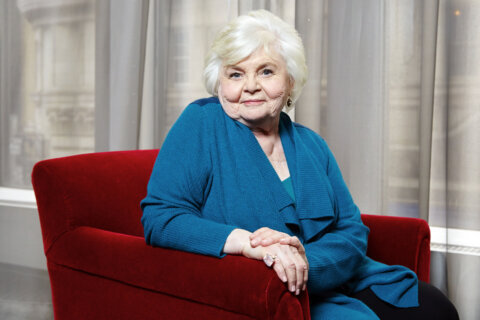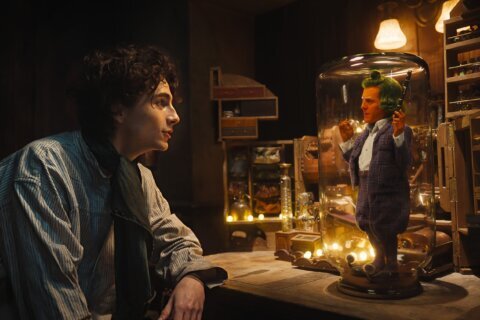Jason Fraley, WTOP film critic
WASHINGTON – If you found “Boogie Nights” (1997) too vulgar, “Magnolia” (1999) too complex, and “There Will Be Blood” (2007) too disturbing, proceed with caution.
If you’d rather spend your hard earned money on neatly packaged movies with tidy ribbons on top, read no further.
And if Biblical frogs and oily milkshakes aren’t your idea of a good time, this movie isn’t for you.
If, however, you dig dangerous filmmaking, crave challenging character studies and want to explore one of the true master filmmakers of our time, follow “The Master.”
Its five-screen, limited release already set box office records for art house theaters, grossing $145,949 per screen to dethrone the $130,749 of “Moonrise Kingdom.”
Friday’s nationwide release includes a midnight screening at the AFI Silver Theatre in Silver Spring, Md., and one of the first offerings at the brand new Angelika Film Center in Fairfax, Va.
Audiences are guaranteed to walk out scratching their heads. Only some will decide they’ve wasted their time, while others will have found film religion.
“The Master” is a critique of cult followers and loosely based on Scientology founder L. Ron Hubbard, whose story is chronicled in a piece by The Village Voice. While the end credits insist the movie isn’t based on actual events – legalese for “don’t sue us, Tom Cruise” – it’s first and foremost a human story, telling of a lonely man seeking acceptance in a larger family structure.
Freddie Quell (Joaquin Phoenix) is a World War II Navy vet who has become a loose cannon drifter in post-war America. He womanizes like a animalistic sex maniac, loses jobs by assaulting total strangers and drinks his own special booze mixed with paint thinner.
One night in San Francisco, Quell stows away on a yacht bound for New York via the Panama Canal. The ship’s captain, Lancaster Dodd (Philip Seymour Hoffman), is a self-proclaimed “writer, doctor, nuclear physicist and theoretical philosopher” whose first book, “The Cause,” has blossomed into a quasi-religion of cult believers who go into trances to recall their past lives.
The impressionable Quell finds acceptance in the group and is gradually brainwashed by Dodd and his wife Peggy (Amy Adams), who have mastered a hypnotizing technique they call “processing.” As Dodd works on his second book, “The Split Saber: A Gift to Homo Sapiens,” Quell begins to suspect his mentor is making everything up as he goes along.
To dissect the film, let’s treat the rest of the review like a series of Dodd’s “processing” questions:
![]()
Can you recall a performance?
The film marks Phoenix’s first real movie since his off-screen meltdown, full of bizarre late night appearances and “I’m Still Here” documentary hoax. This odd behavior allows us to believe his erratic character in “The Master,” as Phoenix arguably gives the most powerful performance of his career.
He seems capable of snapping at any moment, plunging into sexual perversions like humping a mound of beach sand, or violent outbursts to beat down anyone who challenges the cause.
Phoenix will absolutely be in the running for an Oscar and will likely compete against “Lincoln” star Daniel Day-Lewis, whom Anderson directed to the Oscar in “There Will Be Blood.”
The good news for Phoenix is that Day-Lewis already won twice (“My Left Foot” and “There Will Be Blood”) and no actor has won in the lead actor category more than twice. Not Marlon Brando (“On the Waterfront” and “The Godfather”), not Dustin Hoffman (“Kramer vs. Kramer” and “Rain Man”) and not Jack Nicholson (“One Flew Over the Cuckoo’s Nest” and “As Good as it Gets”). Phoenix already has two Oscar nominations for “Gladiator” (2000) and “Walk the Line” (2005). This could be his year.
It should be no surprise that his two most powerful scenes are shared with Oscar- winner Philip Seymour Hoffman (“Capote”), who gives another award worthy performance.
In the first, Hoffman interrogates Phoenix with the instruction not to blink. With eyes watering and face shaking, Phoenix’s eyelids shut, Hoffman makes him start over, and Phoenix slaps himself in the face for motivation. The intensity rivals the Russian roulette scenes from “The Deer Hunter” (1978), only the bullets here are mind games.
The second is a jail cell scene reminiscent of Robert De Niro’s breakdown in “Raging Bull” (1980). With hands handcuffed behind his back, Phoenix lashes out the only way he can, thrusting his head into the bottom of a bunk bed and stomping a toilet to pieces. He screams at his mentor in the adjacent cell, both letting the expletives fly in a scene that’s hard to watch, in a good way.
Hoffman is perfectly at home in his fifth film with Anderson after “Hard Eight,” “Boogie Nights,” “Magnolia” and “Punch-Drunk Love.” He’s a mix of the Paul Dano priest in “There Will Be Blood” and the Tom Cruise self-help character in “Magnolia,” erupting like Al Pacino in “The Godfather” (1972) and carrying the megalomania of Orson Welles in “Citizen Kane” (1941).
Still, despite the commanding force of Hoffman and the palpable anguish of Phoenix, the one performance I can’t shake is that of Adams. Perhaps this is because it’s so subtly horrifying. She’s the one true believer of the cause, the steadfast polar opposite of Laura Dern’s character, who is baffled by Dodd’s decision to change his method from “remembering” past lives to merely “imagining” them.
They say that behind every great man is a great woman, and Adams is the one truly pulling the strings, as seen in an unsettling masturbation scene where Hoffman is, quite literally, in the palm of her hand. This could be the year she, too, gets the supporting actress statue, having been nominated three times for “Junebug” (2005), “Doubt” (2008) and “The Fighter” (2010).
![]()
Can you recall a sound?
Perhaps the most important character in the entire film is that which is with us the whole way through – Jonny Greenwood’s music.
The Radiohead band member has written songs for movies as far back as “Romeo + Juliet” (1996). He also scored the documentary “Bodysong”(2003), but Anderson gave him his first fiction feature film to score with “There Will Be Blood”.
He’s since scored indie films like “Norwegian Wood” and “We Need to Talk About Kevin.”
In “The Master,” the colorblind Greenwood colors the film more than anything else.
![]()
Can you recall an image?
The look of “The Master” is far from colorblind. It’s Anderson’s first feature film without cinematographer Robert Elswit, who shot “Hard Eight,” “Boogie Nights,” “Magnolia” and “Punch Drunk Love,” before winning an Oscar for best cinematography in “There Will Be Blood.”
This time, Anderson hands the camera to Mihai Malaimare Jr., a favorite of Francis Ford Coppola, who worked with him on “Youth Without Youth” (2007), “Twixt” (2011) and “Tetro”(2009). That’s saying a lot from a director who worked with the likes of Gordon Willis on “The Godfather” (1972) and Vittorio Storano on “Apocalypse Now” (1979).
“The Master” is the first movie filmed in 65 millimeters since Kenneth Branagh’s “Hamlet” (1996), and select theaters like the AFI Silver are projecting it in 70 millimeters. As you watch Phoenix tearing across wide desert vistas on a motorcycle, you’ll think of David Lean’s “Lawrence of Arabia” (1962) and wonder if Phoenix will suffer the same fate.
The film is so gorgeously composed that you could take any still frame and hang it on your wall as art. The visual power of “The Master” proves the compositions in Anderson’s work aren’t solely an extension of Elswit, but at least somewhat a product of Anderson’s own cinematic eye.
![]()
Can you recall a vision?
Writer and director Paul Thomas Anderson may very well be the most talented in a crop of young filmmakers who hit Hollywood in the mid-’90s, such as David Fincher, Darren Aronofsky, Christopher Nolan, Sam Mendes and Wes Anderson.
From the opening title card to the closing credits – Woody Allen-esque bookends of a white font over a black screen – we know we’re in the hands of someone special:
SPOILER ALERT:
- Moving camera.
As seen in the opening of “Boogie Nights” (1997), Anderson is a master of the moving camera. In “The Master,” we get rapid dollies across vast landscapes, following Phoenix running away from his troubles or Hoffman zooming on a motorcycle. The technique is best on display as his camera flows through a beauty shop to the song “Get behind me Satan.”
- Power dynamics.
Anderson also knows how to play our subconscious to show which characters have power in a given scene. In Phoenix’s first meeting with Hoffman, we get a series of reactions shots between the two. Note that Hoffman’s red shirt is always visible in the reaction shots of Phoenix, his large body always present, always in control, while Phoenix is never visible in Hoffman’s shots. This is no longer the case in their final exchange at the end of the film.
- Subjective camera (point of view shots).
Throughout the film, Anderson forces us to see things through the eyes of Pheonix’s character. Most disturbingly, we enter his drunk perspective during a party scene, imagining all female partygoers as naked, including a pregnant Adams. The bizarre nude scene recalls Kubrick’s “Eyes Wide Shut” (1999), Polanski’s “Rosemary’s Baby” (1968) and the orgy scene from Fellini’s “La Dolce Vita” (1960).
We again assume Phoenix’s perspective as Adams hypnotizes him. Breaking the fourth wall, she stares directly at the camera while saying that her eyes are a different color. We watch the color change as our perspective becomes that of Phoenix. We, too, are hypnotized.
- Reaction shot subtext.
Anderson also uses reaction shots to provide subtext to what’s happening on the surface. There’s a scene where Hoffman describes taming a dragon, leading it around by a leash and then teaching it to play dead. Thanks to Anderson’s reaction shots of Phoenix, we realize he’s talking about Phoenix, leading him around by a philosophical leash, all the way to a speech on his second book, which occurs in front of a so-called “Phoenix Congress.”
- Mise-en-scene
Through carefully composed shots, Anderson does not simply show us images that further the plot, but rather, makes us scan the entire frame for symbolic items in the background. As Hoffman hosts a speech, he stands in front a giant world map as wedding streamers create a bow on top of his head. Visually, he is presenting himself, and his cause, as a gift to the world, like the subtitle of his second book, “A Gift to Homo Sapiens.”
In the final conversation between Phoenix and Hoffman, Anderson places a statue of a ship captain on Hoffman’s desk. After being steered by Dodd like a vessel through the entire movie, across recurring shots of water, Dodd says he would steer Hoffman “on a boat all the way to China” if he could. As Phoenix declines, note that the ship captain statue sits in Phoenix’s shots, not Hoffman’s. Phoenix has broken Hoffman’s grasp. He now steers his own ship.
I’m sure there are more directorial techniques at work, so you’ll have to forgive me that this was the best I could do with only one viewing.
Overall, the film kept me fully engaged for the entire 137 minutes, a tribute to Anderson’s pacing and his script’s command to “come aboard [where] our memories aren’t allowed.” This is a rare achievement for a film without a traditional narrative structure, without a true hero and without a specific quest, except that of the quest for one’s self.
Perhaps we are so engrossed because we feel like anything could happen at any time, like the interrogation scene where Hoffman asks Phoenix if he’s unpredictable, then Phoenix promptly farts. Contrast this low-brow humor with the film’s high-brow tone and “The Master” becomes an intriguing cocktail, a mix of Quell’s paint thinner booze and painted sepulchral themes.
![]()
Can you recall a purpose?
While I was actively engaged with the movie, geeking out over its gorgeous shots and symbolic directing techniques, I was less enamored by the ending. And not because it’s an unhappy ending. There are plenty of downer endings that satisfy.
When Hoffman dies in “Midnight Cowboy” (1969), we’re left with a buddy bond that rides on even through death. When Nicholson is lobotomized and suffocated at the end of “One Flew Over the Cuckoo’s Nest” (1975), his tragic fall inspires the institutionalized Chief to make a smashing escape to freedom. And when Mia Farrow is tricked and abandoned at the end of “The Purple Rose of Cairo” (1985), we see her return to the comfort of a movie theater and smile at Fred Astaire and Ginger Rogers. These unhappy endings work because despite the hero’s defeat, the theme shines through and we feel satisfied in our dissatisfaction.
To me, the third act of “The Master” falls flat after a beautiful motorcycle sequence, which would have been a powerful shot for Anderson to end the film on. Trying to stay one step ahead of the movie, I imagined one of two alternate endings:
SPOILER ALERT:
- Happy ending
Phoenix leaves the cult lifestyle on his motorcycle, returns to his hometown to find his lost girl that got away, apologizes and they live happily ever after. This ending would be a lazy cop out, but the inspirational message would be clear.
- Unhappy ending
Phoenix leaves the cult lifestyle on his motorcycle, returns to his hometown to find his lost girl that got away, finds out that she has moved on in his absence and thus returns to the cult as his only brainwashed salvation. This ending would be tragic, but satisfying in its melancholy with a clear message of humans seeking acceptance in the group dynamic.
Anderson goes with neither of these. Instead, Phoenix abandons the lifestyle, seeks out his girl, learns she’s gone and returns to the cult in England. Then, he immediately gets out again, sleeps with a chubby woman and lays his head by sandy breasts on a beach. The end. Something’s missing.
I suppose Anderson’s point is that a life free of religion and groupthink is happiness, capturing Hoffman’s cynical line, “If you figure out a way to live without a master, any master, be sure to let the rest of us know, for you would be the first in the history of the world.”
Under this message, Anderson fulfills the hero’s need the minute he leaves the cult for a life of utter free will. Personally, I’d rather not live a life humping female sand castles, but as critics, we can’t judge a film’s worth by whether we agree with its message, only by how well that message is communicated. For me, act three wasn’t up to the challenge posed by the previous two hours.
Later on, thinking it over, I considered the film’s theme of cult following, and thought maybe the joke is on us. Maybe this is Anderson’s point. He is the master creating a beautiful, engrossing, hypnotic work, championing the cause of cinematic art, roaring on like a Purpose Driven Film, which ultimately leaves us grasping for answers.
I’m onto you, Anderson. And so, I’ll tip my hat to your wooly cleverness, as some critics jump on your bandwagon of genius, not knowing why, blindly following a cinematic cult of personality and hailing a masterpiece while knowing deep down “The Master” is slightly less than that.
“There Will Be Blood” will be studied decades from now, gaining in stature as it comes to mark the height of our violent addiction to Middle Eastern oil, but its follow up film is a self-fulfilling prophecy, echoing Dodd’s son when he says, “He’s making all this up as he goes along. You don’t see that?”
Anderson is Dodd, we’re Quell and “The Master” is “The Split Sabre” that cheapens “The Cause.” In order to proclaim its greatness, we must transition from recalling a masterpiece to imagining one.
I’ve seen the light. It’s gorgeous. Intense. Blindingly hollow. But I can’t wait to see it again.
★ ★ ★ 1/2
The above rating is based on a 4-star scale. Read more from WTOP Film Critic Jason Fraley by clicking “Fraley on Film” under the “Living” tab above, following @JasonFraleyWTOP on Twitter, and checking out his blog, The Film Spectrum.
(Copyright 2012 by WTOP. All Rights Reserved.)










